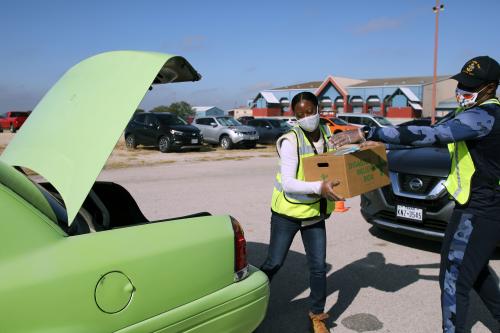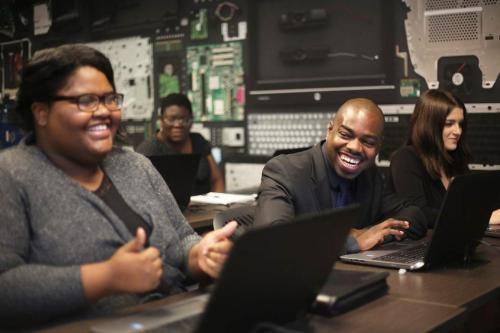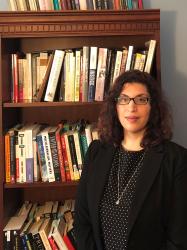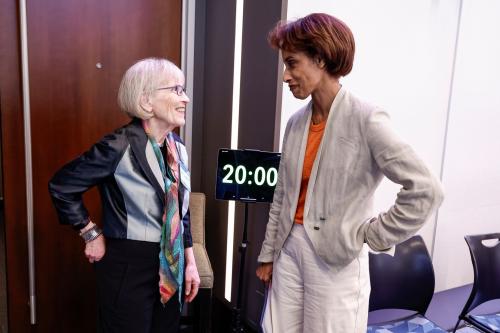This analysis is part of the American Rescue Plan: Strategies for Local Leaders series, a feature of the COVID-19 Metro Recovery Watch.
In cities and counties across the country, summer youth employment programs (SYEPs) stand out as some of the largest and most high-profile youth workforce development initiatives around. At least, they did before COVID-19. Like so many other aspects of life, SYEPs were thrown into disarray last year by the social distancing measures that began in March 2020. SYEPs typically place youth ages 14 to 24 in community-based or private sector jobs for 20-25 hours per week for about six weeks in the summer months. But the onset of stay-at-home orders last spring and drastically reduced business activity made a normal SYEP impossible.
As we approach our second summer shaped by the pandemic, we should take the Biden administration’s “build back better” as inspiration and think more broadly about SYEPs as youth development opportunities and critical touchpoints in the lives of young people. This is especially crucial after a year of remote schooling and isolation and when education and labor markets have been so disrupted. As of April, unemployment rates were higher and rising among Black (18.9 percent) and Latino or Hispanic (17.0) teens compared to their white (11.1 percent) peers.
How one SYEP pivoted: Lessons from Boston
Boston, like other cities, faced unprecedented uncertainty last spring just when it would normally be deep in the SYEP planning process and about to ramp up operations. Some cities chose to cancel their SYEPs, while others rapidly adapted their format and/or reduced their enrollment goals. Common adaptations included virtual internships, engaging youth as crisis responders, and relying heavily on online platforms to build a sense of community as well as provide education and training.
Under the leadership of Mayor Marty Walsh (now the U.S. Secretary of Labor), Boston directed an additional $4.1M of CARES Act funding toward the 2020 SYEP, and committed to serving the same number of youth, for the same number of hours, at the same rate of pay.
Among the revised offerings in Boston’s 2020 SYEP were two new tracks:
- Earn and Learn: To boost post-secondary aspirations after a difficult school year, Boston negotiated agreements to enroll 500 youth in college courses to earn credit and certifications such as Google’s IT Support Professional certificate while getting paid for their experiences.
- Virtual Internships: To help support companies and community-based organizations transition their summer jobs online, Boston partnered with Northeastern University to provide a platform with ready-made projects, collaboration supports, and a quality assurance and management dashboard to engage 500 youth under the guidance of a manager or mentor.
Data collected from an end-of-summer survey showed that participants in both tracks had positive experiences relative to the control group (youth who were not randomly selected to participate in the program). Most of the youth in the control group did not find a job and among those who did, most were engaged in informal work such as baby sitting. In comparison, SYEP participants had a structured placement with either an employer or a community college, were engaged for more hours per week, and gave their job experiences a higher satisfaction rating at the end of the summer.
As described further below, based on this initial success, the city of Boston and the state of Massachusetts plan to incorporate these program models moving forward.
Virtual internships build skills similar to in-person jobs while increasing both flexibility and equity
Boston discovered that virtual internships offered the opportunity for greater project-based learning during which students could gain knowledge and skills by working during the summer to investigate and respond to a real-world, engaging, and complex question/problem/challenge under the direction of a supervisor. As a result, participants indicated that virtual internships were better matches with their career interests than in-person job offerings. Moreover, they were equally or more likely to report developing work habits and soft skills compared to those in in-person jobs such as handing in assignments on time, asking for directions when things are unclear, working in teams, and not getting upset when others corrected their mistakes.
Virtual internships can reduce geographic and time constraints that previously were barriers to participation for youth living in low-income neighborhoods or those with extracurricular and/or caregiving activities. Moreover, using an online platform as the work environment equips youth with the technology skills needed to bridge the digital divide and better prepare them for the workplace of the future, which is likely to maintain some virtual component.
State and local leaders are intrigued by the potential of virtual internships to provide both increased flexibility and equity as well as greater integration with academic learning. During the 2020-21 school year, Boston experimented with a year-round virtual internship program integrating both academic and employment-based skills. Massachusetts is also piloting a virtual internship program to provide greater access to employment opportunities with private sector employers for academic credit during the school year.
Learn and Earn programs increase post-secondary access and aspirations
Most Learn and Earn participants (88%) completed their courses, and 78% passed their courses for credit. Learn and Earn youth were also more likely to report that their college coaches helped with career and education goal setting and by the end of the summer were 10 percentage points more likely to say they were planning to enroll in a four year college compared to the control group. They also showed increased levels of self-regulation, self-efficacy beliefs, and intrinsic interest, which significantly predict future academic performance.
The success of the Learn and Earn program has had far-reaching implications for the workforce development landscape in Boston. As a conditional cash transfer program, it provides income to young people contingent upon their participation in educational activities. It thus addresses two key obstacles that have hampered post-secondary transitions for low-income youth. The first is eliminating or drastically reducing the financial opportunity costs associated with pursuing education so that teens did not have to choose between getting a job or going to school. Secondly, by providing a college coach who acted as a mentor and tutor, the program helped address potential problems that could have derailed their coursework.
Based on the experiences of this past summer, workforce development planers in Boston are exploring the idea of expanding conditional cash transfer models, including learn and earn, for the city’s portfolio of youth programs funded through the federal Workforce Innovation and Opportunity Act (WIOA).
How can cities use SYEP to build back better for youth?
SYEPs hold tremendous potential—multiple studies in different cities found that they have positive effects. In Boston alone, the city’s partnership with Northeastern University has produced evidence that the city’s summer jobs program improves a range of academic, behavioral, and employment outcomes, with greater impacts for youth of color and a benefit-to-cost ratio of more than 2-to-1.
But they are complex endeavors to organize, and it is easier to focus on the headline figure of the number of youth placed rather than the operational, program design, and performance details that assure quality.
We should take the positive results as a challenge to clarify what we want out of these programs and to raise a corollary question: Do they have the funding, design, and execution to fully reach their stated goals? If not, we are missing out on a tremendous opportunity to engage with young people at a moment in their lives when they are both receptive and vulnerable.
Below are keys issues to focus on:
- Learn more about how to teach and assess soft skills—these skills are absolutely vital to future success in the labor market.
- Prioritize strategies that ensure every young person has an engaged supervisor or mentor—we know from the field of youth development that positive, supportive relationships with adults are as important as any other element of program design.
- Test how to use project-based learning, either in-person or virtually, that could be used widely by both schools and nonprofits as a form of work-based learning not limited to the summer.
- Use SYEPS to explore the potential of conditional cash transfer programs to promote greater economic mobility by increasing incentives and support for education, training, and employment-related activities.
This is a moment for action and investment. In the past year, young people have experienced unprecedented disruptions in their education and in the job market. American Rescue Plan funds are flowing soon to states and localities including $350 billion in flexible dollars of which some portion could be directed toward youth programs. Another $22 billion will go to local education agencies to be targeted for afterschool, summer, and extended learning time activities. Using even a relatively small allocation of these dollars, state and local leaders can build a more holistic youth workforce development system that can be sustained beyond the current crisis to better set young people up for success in life and work.











Commentary
To “build back better,” we must connect young people to jobs and education
May 20, 2021